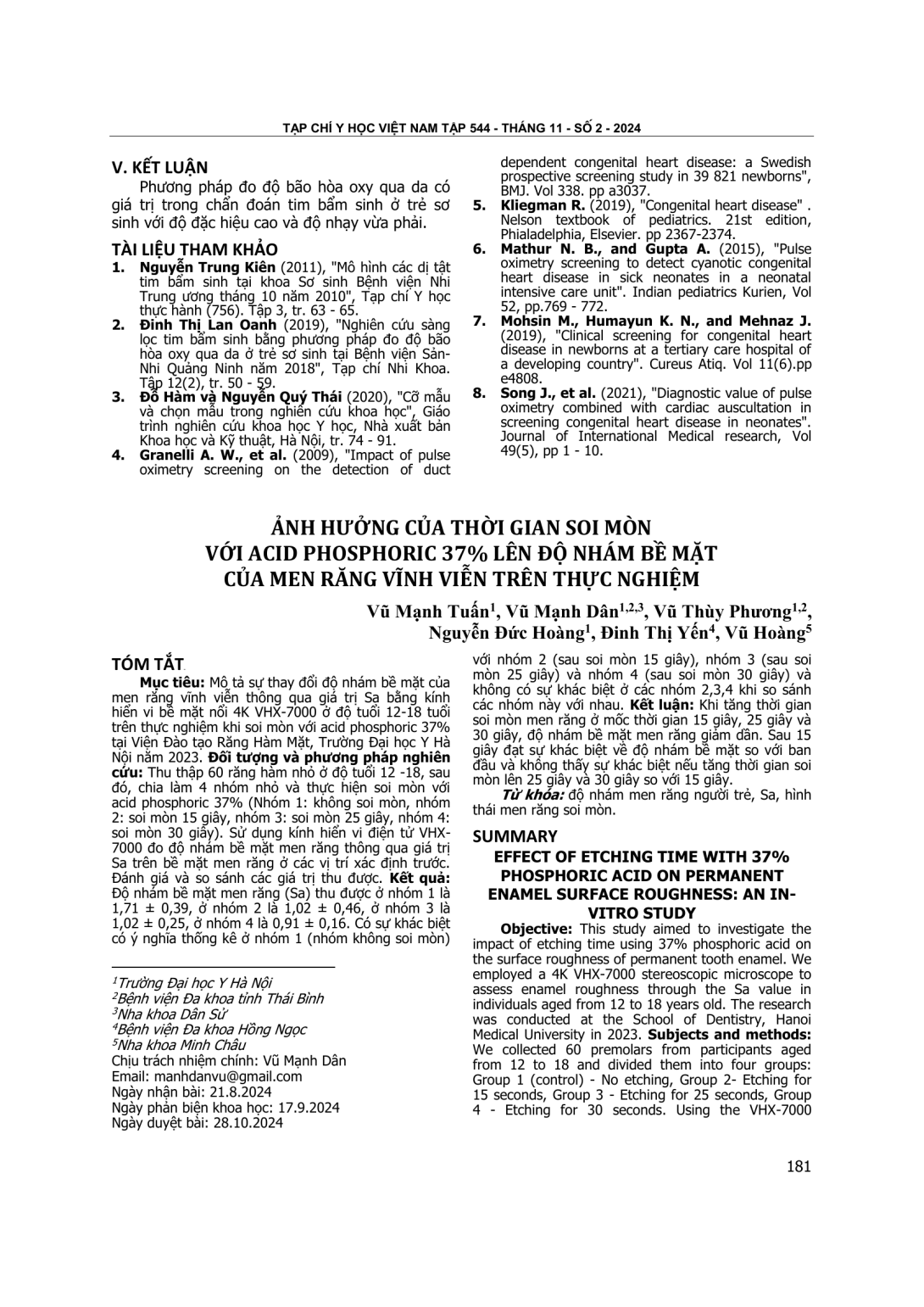
Mô tả sự thay đổi độ nhám bề mặt của men răng vĩnh viễn thông qua giá trị Sa bằng kính hiển vi bề mặt nổi 4K VHX-7000 ở độ tuổi 12-18 tuổi trên thực nghiệm khi soi mòn với acid phosphoric 37% tại Viện Đào tạo Răng Hàm Mặt, Trường Đại học Y Hà Nội năm 2023. Đối tượng và phương pháp nghiên cứu: Thu thập 60 răng hàm nhỏ ở độ tuổi 12 -18, sau đó, chia làm 4 nhóm nhỏ và thực hiện soi mòn với acid phosphoric 37% (Nhóm 1: không soi mòn, nhóm 2: soi mòn 15 giây, nhóm 3: soi mòn 25 giây, nhóm 4: soi mòn 30 giây). Sử dụng kính hiển vi điện tử VHX-7000 đo độ nhám bề mặt men răng thông qua giá trị Sa trên bề mặt men răng ở các vị trí xác định trước. Đánh giá và so sánh các giá trị thu được. Kết quả: Độ nhám bề mặt men răng (Sa) thu được ở nhóm 1 là 1,71 ± 0,39, ở nhóm 2 là 1,02 ± 0,46, ở nhóm 3 là 1,02 ± 0,25, ở nhóm 4 là 0,91 ± 0,16. Có sự khác biệt có ý nghĩa thống kê ở nhóm 1 (nhóm không soi mòn) với nhóm 2 (sau soi mòn 15 giây), nhóm 3 (sau soi mòn 25 giây) và nhóm 4 (sau soi mòn 30 giây) và không có sự khác biệt ở các nhóm 2,3,4 khi so sánh các nhóm này với nhau. Kết luận: Khi tăng thời gian soi mòn men răng ở mốc thời gian 15 giây, 25 giây và 30 giây, độ nhám bề mặt men răng giảm dần. Sau 15 giây đạt sự khác biệt về độ nhám bề mặt so với ban đầu và không thấy sự khác biệt nếu tăng thời gian soi mòn lên 25 giây và 30 giây so với 15 giây.
This study aimed to investigate the impact of etching time using 37% phosphoric acid on the surface roughness of permanent tooth enamel. We employed a 4K VHX-7000 stereoscopic microscope to assess enamel roughness through the Sa value in individuals aged from 12 to 18 years old. The research was conducted at the School of Dentistry, Hanoi Medical University in 2023. Subjects and methods: We collected 60 premolars from participants aged from 12 to 18 and divided them into four groups: Group 1 (control) - No etching, Group 2- Etching for 15 seconds, Group 3 - Etching for 25 seconds, Group 4 - Etching for 30 seconds. Using the VHX-7000 electron microscope, we measured enamel surface roughness at predetermined positions. Subsequently, we evaluated and compared the obtained Sa values. Results: Our findings revealed that enamel surface roughness (Sa) decreased as the etching time increased. Statistically significant differences were observed between the non-etching group and the 15-second, 25-second, and 30-second etching groups. However, no significant differences were found among the 15-second, 25-second, and 30-second etching groups when compared to each other. Conclusion: Increasing the enamel etching time to 15 seconds, 25 seconds, and 30 seconds led to a gradual reduction in surface roughness. Notably, after 15 seconds of etching, a discernible difference in roughness was observed compared to the initial level. However, extending the etching time to 25 seconds and 30 seconds did not yield further differences compared to the 15-second duration.
- Đăng nhập để gửi ý kiến
